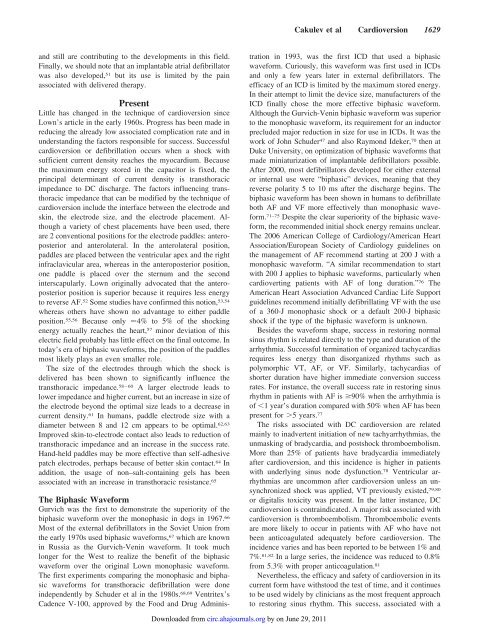Cardioversion Past, Present, and Future - the Laboratory of Igor Efimov
Cardioversion Past, Present, and Future - the Laboratory of Igor Efimov
Cardioversion Past, Present, and Future - the Laboratory of Igor Efimov
Create successful ePaper yourself
Turn your PDF publications into a flip-book with our unique Google optimized e-Paper software.
Cakulev et al <strong>Cardioversion</strong> 1629<strong>and</strong> still are contributing to <strong>the</strong> developments in this field.Finally, we should note that an implantable atrial defibrillatorwas also developed, 51 but its use is limited by <strong>the</strong> painassociated with delivered <strong>the</strong>rapy.<strong>Present</strong>Little has changed in <strong>the</strong> technique <strong>of</strong> cardioversion sinceLown’s article in <strong>the</strong> early 1960s. Progress has been made inreducing <strong>the</strong> already low associated complication rate <strong>and</strong> inunderst<strong>and</strong>ing <strong>the</strong> factors responsible for success. Successfulcardioversion or defibrillation occurs when a shock withsufficient current density reaches <strong>the</strong> myocardium. Because<strong>the</strong> maximum energy stored in <strong>the</strong> capacitor is fixed, <strong>the</strong>principal determinant <strong>of</strong> current density is transthoracicimpedance to DC discharge. The factors influencing transthoracicimpedance that can be modified by <strong>the</strong> technique <strong>of</strong>cardioversion include <strong>the</strong> interface between <strong>the</strong> electrode <strong>and</strong>skin, <strong>the</strong> electrode size, <strong>and</strong> <strong>the</strong> electrode placement. Althougha variety <strong>of</strong> chest placements have been used, <strong>the</strong>reare 2 conventional positions for <strong>the</strong> electrode paddles: anteroposterior<strong>and</strong> anterolateral. In <strong>the</strong> anterolateral position,paddles are placed between <strong>the</strong> ventricular apex <strong>and</strong> <strong>the</strong> rightinfraclavicular area, whereas in <strong>the</strong> anteroposterior position,one paddle is placed over <strong>the</strong> sternum <strong>and</strong> <strong>the</strong> secondinterscapularly. Lown originally advocated that <strong>the</strong> anteroposteriorposition is superior because it requires less energyto reverse AF. 52 Some studies have confirmed this notion, 53,54whereas o<strong>the</strong>rs have shown no advantage to ei<strong>the</strong>r paddleposition. 55,56 Because only 4% to 5% <strong>of</strong> <strong>the</strong> shockingenergy actually reaches <strong>the</strong> heart, 57 minor deviation <strong>of</strong> thiselectric field probably has little effect on <strong>the</strong> final outcome. Intoday’s era <strong>of</strong> biphasic waveforms, <strong>the</strong> position <strong>of</strong> <strong>the</strong> paddlesmost likely plays an even smaller role.The size <strong>of</strong> <strong>the</strong> electrodes through which <strong>the</strong> shock isdelivered has been shown to significantly influence <strong>the</strong>transthoracic impedance. 58–60 A larger electrode leads tolower impedance <strong>and</strong> higher current, but an increase in size <strong>of</strong><strong>the</strong> electrode beyond <strong>the</strong> optimal size leads to a decrease incurrent density. 61 In humans, paddle electrode size with adiameter between 8 <strong>and</strong> 12 cm appears to be optimal. 62,63Improved skin-to-electrode contact also leads to reduction <strong>of</strong>transthoracic impedance <strong>and</strong> an increase in <strong>the</strong> success rate.H<strong>and</strong>-held paddles may be more effective than self-adhesivepatch electrodes, perhaps because <strong>of</strong> better skin contact. 64 Inaddition, <strong>the</strong> usage <strong>of</strong> non–salt-containing gels has beenassociated with an increase in transthoracic resistance. 65The Biphasic WaveformGurvich was <strong>the</strong> first to demonstrate <strong>the</strong> superiority <strong>of</strong> <strong>the</strong>biphasic waveform over <strong>the</strong> monophasic in dogs in 1967. 66Most <strong>of</strong> <strong>the</strong> external defibrillators in <strong>the</strong> Soviet Union from<strong>the</strong> early 1970s used biphasic waveforms, 67 which are knownin Russia as <strong>the</strong> Gurvich-Venin waveform. It took muchlonger for <strong>the</strong> West to realize <strong>the</strong> benefit <strong>of</strong> <strong>the</strong> biphasicwaveform over <strong>the</strong> original Lown monophasic waveform.The first experiments comparing <strong>the</strong> monophasic <strong>and</strong> biphasicwaveforms for transthoracic defibrillation were doneindependently by Schuder et al in <strong>the</strong> 1980s. 68,69 Ventritex’sCadence V-100, approved by <strong>the</strong> Food <strong>and</strong> Drug Administrationin 1993, was <strong>the</strong> first ICD that used a biphasicwaveform. Curiously, this waveform was first used in ICDs<strong>and</strong> only a few years later in external defibrillators. Theefficacy <strong>of</strong> an ICD is limited by <strong>the</strong> maximum stored energy.In <strong>the</strong>ir attempt to limit <strong>the</strong> device size, manufacturers <strong>of</strong> <strong>the</strong>ICD finally chose <strong>the</strong> more effective biphasic waveform.Although <strong>the</strong> Gurvich-Venin biphasic waveform was superiorto <strong>the</strong> monophasic waveform, its requirement for an inductorprecluded major reduction in size for use in ICDs. It was <strong>the</strong>work <strong>of</strong> John Schuder 47 <strong>and</strong> also Raymond Ideker, 70 <strong>the</strong>n atDuke University, on optimization <strong>of</strong> biphasic waveforms thatmade miniaturization <strong>of</strong> implantable defibrillators possible.After 2000, most defibrillators developed for ei<strong>the</strong>r externalor internal use were “biphasic” devices, meaning that <strong>the</strong>yreverse polarity 5 to 10 ms after <strong>the</strong> discharge begins. Thebiphasic waveform has been shown in humans to defibrillateboth AF <strong>and</strong> VF more effectively than monophasic waveform.71–75 Despite <strong>the</strong> clear superiority <strong>of</strong> <strong>the</strong> biphasic waveform,<strong>the</strong> recommended initial shock energy remains unclear.The 2006 American College <strong>of</strong> Cardiology/American HeartAssociation/European Society <strong>of</strong> Cardiology guidelines on<strong>the</strong> management <strong>of</strong> AF recommend starting at 200 J with amonophasic waveform. “A similar recommendation to startwith 200 J applies to biphasic waveforms, particularly whencardioverting patients with AF <strong>of</strong> long duration.” 76 TheAmerican Heart Association Advanced Cardiac Life Supportguidelines recommend initially defibrillating VF with <strong>the</strong> use<strong>of</strong> a 360-J monophasic shock or a default 200-J biphasicshock if <strong>the</strong> type <strong>of</strong> <strong>the</strong> biphasic waveform is unknown.Besides <strong>the</strong> waveform shape, success in restoring normalsinus rhythm is related directly to <strong>the</strong> type <strong>and</strong> duration <strong>of</strong> <strong>the</strong>arrhythmia. Successful termination <strong>of</strong> organized tachycardiasrequires less energy than disorganized rhythms such aspolymorphic VT, AF, or VF. Similarly, tachycardias <strong>of</strong>shorter duration have higher immediate conversion successrates. For instance, <strong>the</strong> overall success rate in restoring sinusrhythm in patients with AF is 90% when <strong>the</strong> arrhythmia is<strong>of</strong> 1 year’s duration compared with 50% when AF has beenpresent for 5 years. 77The risks associated with DC cardioversion are relatedmainly to inadvertent initiation <strong>of</strong> new tachyarrhythmias, <strong>the</strong>unmasking <strong>of</strong> bradycardia, <strong>and</strong> postshock thromboembolism.More than 25% <strong>of</strong> patients have bradycardia immediatelyafter cardioversion, <strong>and</strong> this incidence is higher in patientswith underlying sinus node dysfunction. 78 Ventricular arrhythmiasare uncommon after cardioversion unless an unsynchronizedshock was applied, VT previously existed, 79,80or digitalis toxicity was present. In <strong>the</strong> latter instance, DCcardioversion is contraindicated. A major risk associated withcardioversion is thromboembolism. Thromboembolic eventsare more likely to occur in patients with AF who have notbeen anticoagulated adequately before cardioversion. Theincidence varies <strong>and</strong> has been reported to be between 1% <strong>and</strong>7%. 81,82 In a large series, <strong>the</strong> incidence was reduced to 0.8%from 5.3% with proper anticoagulation. 81Never<strong>the</strong>less, <strong>the</strong> efficacy <strong>and</strong> safety <strong>of</strong> cardioversion in itscurrent form have withstood <strong>the</strong> test <strong>of</strong> time, <strong>and</strong> it continuesto be used widely by clinicians as <strong>the</strong> most frequent approachto restoring sinus rhythm. This success, associated with aDownloaded from circ.ahajournals.org by on June 29, 2011



